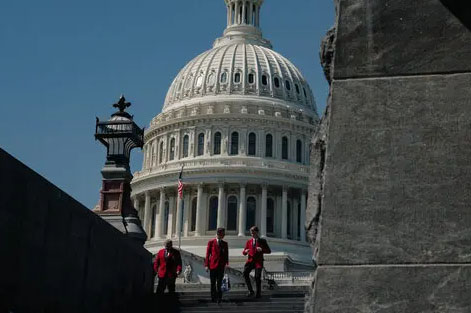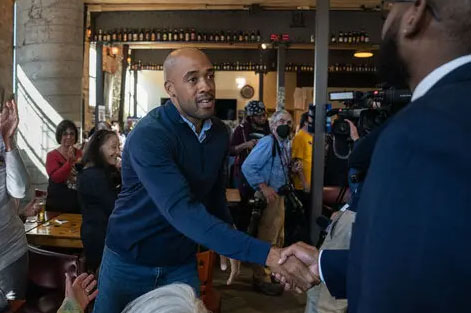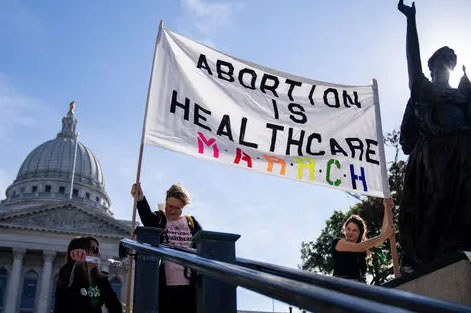|
|
|
|
|
|
 |
|
|
The
G.O.P.
claimed
the
momentum
in the
spring.
Then the
overturning
of Roe
v. Wade
galvanized
Democrats.
As the
momentum
shifts
again,
the
final
stretch
of the
2022
midterms
defies
predictability.
Republicans
are
bullish
on
taking
the
House in
November,
but the
Senate
is up
for
grabs.
Credit...Shuran
Huang
for The
New York
Times |
| |
4 Weeks
Out,
Senate
Control
Hangs in
the
Balance
in
Tumultuous
Midterms
B Shane
Goldmacher,
Reid J.
Epstein,
and
Jonathan
Weisman
nytimes.com
Exactly
one
month
until
Election
Day,
Republicans
remain
favored
to take
over the
House in
November,
but
momentum
in the
pitched
battle
for the
Senate
has
seesawed
back and
forth as
a
multimillion-dollar
avalanche
of
advertising
has
blanketed
the top
battleground
states.
For
almost
two
decades,
midterm
elections
have
been a
succession
of
partisan
waves:
for
Democrats
in 2006,
Republicans
in 2010
and
2014,
and
Democrats
again in
2018.
Yet as
the
first
mail-in
ballots
go out
to
voters,
the
outcome
of the
2022
midterms
on Nov.
8
appears
unusually
unpredictable
— a
reason
for
optimism
for
Democrats,
given
how
severely
the
party
that
holds
the
White
House
has been
punished
in
recent
years.
Three
states
in
particular
—
Georgia,
Nevada
and
Pennsylvania
— that
are seen
as the
likeliest
to
change
party
hands
have
emerged
as the
epicenter
of the
Senate
fight
with an
increasing
volume
of
acrimony
and
advertising.
In many
ways,
the two
parties
have
been
talking
almost
entirely
past
each
other
both on
the
campaign
trail
and on
the
airwaves
—
disagreeing
less
over
particular
policies
than
debating
entirely
different
lists of
challenges
and
threats
facing
the
nation.
Republicans
have
pounded
voters
with
messages
about
the
lackluster
economy,
frightening
crime,
rising
inflation
and an
unpopular
President
Biden.
Democrats
have
countered
by
warning
about
the
stripping
away of
abortion
rights
and the
specter
of
Donald
J.
Trump’s
allies
returning
to
power.
Both
parties
are
tailoring
their
messages
to reach
suburban
voters,
especially
women,
who are
seen as
the most
prized
and
persuadable
bloc in
a
polarized
electorate.

Democrats
have
warned
that
Republican
gains in
the
midterms
would
usher in
the
return
of
Donald
J.
Trump’s
movement
to
power.
Credit...Brittany
Greeson
for The
New York
Times
The year
has
progressed
like a
political
roller
coaster.
Republicans
boasted
that a
typical
wave was
building
in the
spring,
and
Democrats
then
claimed
the
momentum
after
the
Supreme
Court’s
decision
overturning
Roe v.
Wade
galvanized
progressive
and
independent
voters.
Now the
pendulum
seems to
have
swung
back.
“I wish
the
election
was a
month
ago,”
conceded
Navin
Nayak, a
Democratic
strategist
and the
president
of the
Center
for
American
Progress
Action
Fund. He
was
heartened,
however,
to see
his
party
with a
fighter’s
chance,
adding
that
Democrats
had “no
business
being in
this
election.”
The
challenge
for
Democrats
is that
they
also
have no
margin
for
error.
Clinging
to a
50-50
Senate
and a
single-digit
House
majority,
they are
seeking
to defy
not only
history
but Mr.
Biden’s
unpopularity.
“Even
the
slightest
tremor
is going
to put
the
Democrats
in the
minority,”
as Peter
Hart, a
longtime
Democratic
pollster,
put it.
Come
November,
whichever
party’s
issue
set is
more
dominant
in the
minds of
the
electorate
is
expected
to have
the
upper
hand.
“The
Democrats’
message
is,
‘Elect
Republicans
and the
sky may
fall!’”
Paul
Shumaker,
a
veteran
Republican
strategist
based in
North
Carolina,
said,
referring
to
rhetoric
around
abortion
and
Trumpism.
But he
said
that
voters
“see the
sky is
falling
— all
because
of Joe
Biden’s
bad
economy.
The
increase
in
prices
at the
grocery
store is
an
everyday
fact of
life.”
Republicans
are
bullish
on
taking
the
House.
Representative
Elise
Stefanik
of New
York,
the
chair of
the
House
Republican
Conference,
predicted
a “red
tsunami”
in an
interview.
“I think
we can
win over
35
seats,
which
would
give us
the
largest
majority
since
the
Great
Depression,”
she
said.
Republicans,
in fact,
need
only a
red
ripple
to take
the
gavel
from
Speaker
Nancy
Pelosi’s
current
threadbare
220-member
majority.
For
Democrats
to
maintain
power,
they
would
need a
near
sweep of
the
battleground
districts,
winning
roughly
80
percent
of them,
according
to
political
analysts
who rate
the
competitiveness
of
races.
Dan
Conston,
who
heads
the
Congressional
Leadership
Fund,
the
super
PAC
aligned
with the
House
Republican
leadership,
noted
that if
Republicans
win
every
seat
that Mr.
Trump
carried,
plus
every
seat
that Mr.
Biden
won by
five
percentage
points
or less,
they
would
secure
224
seats, a
narrow
six-seat
majority.
“The
political
environment
has
moved in
multiple
ways
this
cycle
and has
more
contrasting
issues
that are
keeping
both
sides
engaged
and
energized,”
Mr.
Conston
said.

Republicans
have
improved
their
standing
in
several
key
Senate
races,
including
one in
Wisconsin,
where
Lt. Gov.
Mandela
Barnes,
the
Democratic
candidate,
has
struggled
recently.
Credit...Haiyun
Jiang/The
New York
Times
It is
Republican
super
PAC
spending
that has
frightened
House
Democrats
most in
recent
weeks.
“We
always
knew
this
would be
tough,”
Representative
Sean
Patrick
Maloney
of New
York,
chairman
of the
Democratic
Congressional
Campaign
Committee,
said in
an
interview.
Of the
super
PAC cash
deficit,
he said,
“We just
need
enough.”
In the
Senate,
the
battlefield
has been
shaped
by
powerful
crosscurrents
and has
swelled
to as
many as
10
states —
and if a
single
state
flips to
the
Republicans,
they
would
control
the
chamber.
Republicans
have
improved
their
standing
in
several
key
Senate
races —
including
those in
Nevada,
Pennsylvania
and
Wisconsin
— by
pummeling
Democrats
over
crime.
But
those
gains
have
been
offset
in part
by the
struggles
of
several
Republican
nominees,
including
those in
Arizona
and in
Georgia,
where
Herschel
Walker’s
campaign
has been
engulfed
by the
allegation
that he
financed
an
abortion
for a
former
girlfriend.

At a
campaign
stop in
Wadley,
Ga.,
Herschel
Walker,
the
Republican
Senate
candidate,
dismissed
a report
that he
had paid
for an
ex-girlfriend’s
abortion.
Credit...Nicole
Buchanan
for The
New York
Times
One of
the most
significant
Senate
developments
came in
New
Hampshire,
where
Republicans
nominated
Don
Bolduc
in
September
despite
warnings
in
Republican-funded
television
ads that
his
“crazy
ideas”
would
make him
unelectable.
In a
recent
radio
interview,
Senator
Rick
Scott,
the
chairman
of the
National
Republican
Senatorial
Committee,
pointedly
did not
include
New
Hampshire
among
his
party’s
top five
pickup
opportunities.
And late
Friday,
Mr.
Scott’s
group
began
canceling
more
than $5
million
it had
reserved
there,
saying
it was
redirecting
the
funds
elsewhere.
Recruiting
failures
have
hampered
Senate
Republicans
throughout
2022,
and
Senator
Mitch
McConnell,
the
minority
leader,
complained
over the
summer
about
“candidate
quality.”
How
Times
reporters
cover
politics.
We rely
on our
journalists
to be
independent
observers.
So while
Times
staff
members
may
vote,
they are
not
allowed
to
endorse
or
campaign
for
candidates
or
political
causes.
This
includes
participating
in
marches
or
rallies
in
support
of a
movement
or
giving
money
to, or
raising
money
for, any
political
candidate
or
election
cause.
But most
Senate
strategists
now see
control
of the
chamber
hinging
particularly
on
Nevada
and
Georgia,
where
Democratic
incumbents
are
seeking
re-election,
and
Pennsylvania,
an open
seat
held by
a
retiring
Republican.
And
whichever
party
wins two
of those
three
would be
strongly
favored
to be in
the
majority.
Both
sides
are
still
seeking
to
stretch
the map.
A
Democratic
super
PAC just
injected
more
money
into
North
Carolina,
and
Republicans
have
talked
up their
chances
in
Colorado.
Millions
of
dollars
are
funding
ads
focusing
on
Republican-held
seats in
Ohio and
Florida,
as well.
“This is
the
strangest
midterm
I’ve
ever
been a
part of,
because
you have
these
two
things
in
direct
conflict,”
said Guy
Cecil, a
veteran
campaign
operative
who
chairs
the
Democratic
group
Priorities
USA.
“You
have
what
history
tells
us, and
you have
all this
data
that
says
it’s
going to
be a
very
close
election.”
Looming
over the
political
environment
is the
unpopularity
of Mr.
Biden.
Polls
show he
has
recovered
from his
lowest
points
over the
summer
after
signing
legislation
that
addressed
climate
change
and
senior
drug
prices.
A dip in
gas
prices
helped,
too.
But his
approval
remains
mired in
the low
40-percent
range,
and gas
prices
began
ticking
back up
even
before
the
recent
decision
by Saudi
Arabia
and
Russia
to cut
oil
production.
Democrats
have
repeatedly
framed
the
election
as a
choice
and
warned
that
Republican
gains
would
usher in
the
return
to power
of Mr.
Trump’s
movement.
Representative
Hakeem
Jeffries
of New
York,
chairman
of the
House
Democratic
Caucus,
said in
an
interview
that it
was an
urgent
priority
to “make
it clear
that it
is an
untenable
situation
to hand
over the
keys to
the
extremists
in the
other
party.”
Ms.
Stefanik,
the No.
3 House
Republican,
accused
Democrats
of
trying
to
distract
voters.

Supporters
of
abortion
rights
rallied
in
Wisconsin
on the
steps of
the
State
Capitol
in
Madison.
Democrats
have
made the
stripping
away of
abortion
rights a
central
theme of
the
midterms.
Credit...Haiyun
Jiang/The
New York
Times
“The
Democratic
Party is
trying
to turn
this
into a
referendum
on
Trump,”
she
said.
“It is
not. It
is a
referendum
on Joe
Biden.”
Even
more
than Mr.
Trump,
abortion
stands
at the
center
of
virtually
all
Democratic
electoral
hopes
this
year.
Its
persuasive
power
alarmed
Republicans
over the
summer,
especially
after
Kansans
voted
against
a
referendum
that had
threatened
abortion
rights
in the
state
and
Democrats
outperformed
expectations
in some
special
elections.
Gov. Roy
Cooper
of North
Carolina,
the
chairman
of the
Democratic
Governors
Association,
said the
breadth
of the
abortion
decision
had
taken
swing
voters
by
surprise,
despite
years of
warnings
from
advocates
and
predictions
from Mr.
Trump
himself
that his
Supreme
Court
appointees
would do
just
that.
The
shock,
Mr.
Cooper
said,
has not
worn
off.
“I don’t
think
anyone
thought
that
after
their
testimony
in
committee
in the
U.S.
Senate
that
they
would
actually
vote to
turn it
on its
head,”
Mr.
Cooper
said of
Trump-appointed
justices.
Republicans
have
sought a
delicate
two-step
on
abortion,
catering
to a
base
demanding
its
prohibition
and to
the
political
center,
which is
largely
supportive
of Roe.
In
Nevada,
Adam
Laxalt,
the
Republican
Senate
candidate,
is
broadcasting
television
ads
proclaiming
that no
matter
what
happens
in
Washington,
abortion
will
remain
legal in
Nevada,
attempting
to pivot
voter
attention
back to
crime
and the
economy.
“Over
the last
two
years,
Democrat
politicians
have
done
incredible
damage
to
America,”
one ad
intones.
“But one
thing
hasn’t
changed:
abortion
in
Nevada.
Why do
Democrats
like
Catherine
Cortez
Masto
only
talk
about
something
that
hasn’t
changed?
Because
they
can’t
defend
everything
that
has.”

A
supporter
for John
Fetterman,
the
Democratic
Senate
candidate
in
Pennsylvania,
at a
campaign
event in
Murrysville,
Pa., on
Wednesday.
Credit...Justin
Merriman
for The
New York
Times
Republican
fortunes
have
improved
in part
through
enormous
spending
by a
super
PAC
aligned
with
Senator
Mitch
McConnell
of
Kentucky,
which is
funding
a $170
million
television
blitz
across
seven
states
that
started
on Labor
Day and
is set
to
continue
through
the
election.
Crime
has
dominated
the
Republican
messaging
in
Nevada,
Wisconsin
and
Pennsylvania,
where
the
summertime
edge
held by
the
Democratic
nominee,
John
Fetterman,
over Dr.
Mehmet
Oz, the
Republican
nominee,
has
largely
evaporated.
“Dangerously
liberal
on
crime,”
says one
anti-Fetterman
ad in
Pennsylvania.
“This
campaign
weathered
an
unprecedented
six
weeks of
attacks,”
said
Rebecca
Katz, a
senior
strategist
for Mr.
Fetterman.
“And not
only are
we still
standing
— we’re
still
winning.”
In a
twist
for this
era of
hyperpartisanship,
voters
could
render a
number
of split
decisions
between
governor
and
Senate
contests
in
battlegrounds
this
fall.
In
Georgia
and New
Hampshire,
incumbent
Republican
governors
are
leading
in
polls,
outpacing
the
Republican
nominees
for
Senate.
The
opposite
is true
in
Wisconsin,
where
the
Democratic
governor
is
further
ahead in
polling,
as well
as in
Pennsylvania,
where
Josh
Shapiro,
the
Democratic
governor
nominee,
is
leading.
In one
recent
crime
ad, Dr.
Oz, the
celebrity
physician,
notably
drew a
distinction
between
Mr.
Fetterman
and Mr.
Shapiro.
He
seemed
to be
searching
for
crossover
Shapiro-Oz
votes.
|
|
|
|
|
|
|
|
|